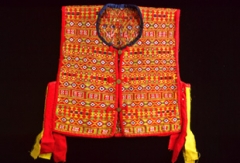TELDAP Collections
| Paiwan short shirt |
|
The Paiwan tribe has a strict social hierarchy that includes the nobility and commoners. Each hierarchical level comes with a unique set of rights and obligations. For example, certain names were only for the use of the upper echelon of society. In addition, those of the common class were not allowed to use certain motifs or patterns on the carved lintels above the door to their homes, on their clothing or on utensils for daily use. These included human head (ancestors) and hundred pace pit viper motifs. Paiwan clothing was made using different methods, styles and designs including weaving (Tjunenun), embroidery (vnetsikan), beading (pinu-luvuts-an), attachment of various decorations (pina-djekets-an) and webbing, etc. The meanings and themes of patterns and decorations are associated with the tribe’s social 1. Symbols of nobility and differentiation of classes. This shirt looks somewhat like a Chinese-style jacket with brightly colored and complicated patterns. It is sleeveless with a round collar. It measures 47 centimeters in length and 43 centimeters across the shoulders. The openings for the arms to go through are 24 to 25 centimeters in length. The background color is red and the weft features varying patterns in red, yellow, green and black. Red cotton cloth is sewn on around the openings for the arms, the collar and along the margins. The collar also has a blue cotton cloth band. The front flaps are fitted together with three traditional Chinese-style buttons. In general, buttons were not often used on traditional clothing because they could not be easily made. Thus, the Paiwan made use of round copper buttons and flat silver buttons produced by the Chinese.
Department of Graphic Communications and Digital Publishing, Shih Hsin University Digital archiving project of the Shung Ye Museum of Formosan Aborigines
|







 The Paiwan is Taiwan’s third largest recognized indigenous tribe. The tribe’s distribution is in low mountain areas at between 100 and 1,000 meters in elevation, including the southern branch of the Central Mountain Range, Damumu Mountain (Taivuvu) and southward to the Hengchun Peninsula. In terms of administrative boundaries, the Paiwan tribe inhabits eight townships in Pingtung County including Sandimen, Majia, Taiwu, Laiyi, Chunri, Mudan, Shizi and Manzhou and five townships in Taitung County including Beinan, Jinfeng, Taimali, Daren and Dawu. There are also a small number of Paiwan living in Zhuoxi Township of Hualien County and Sanmin and Taoyuan counties of Kaohsiung County.
The Paiwan is Taiwan’s third largest recognized indigenous tribe. The tribe’s distribution is in low mountain areas at between 100 and 1,000 meters in elevation, including the southern branch of the Central Mountain Range, Damumu Mountain (Taivuvu) and southward to the Hengchun Peninsula. In terms of administrative boundaries, the Paiwan tribe inhabits eight townships in Pingtung County including Sandimen, Majia, Taiwu, Laiyi, Chunri, Mudan, Shizi and Manzhou and five townships in Taitung County including Beinan, Jinfeng, Taimali, Daren and Dawu. There are also a small number of Paiwan living in Zhuoxi Township of Hualien County and Sanmin and Taoyuan counties of Kaohsiung County.




